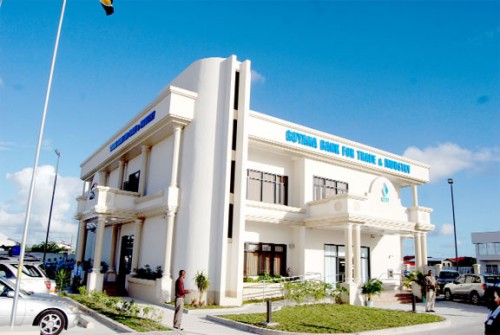Five months after Chairman Robin Stoby declared GBTI’s intention to assume the number one position in the country’s banking sector, the bank’s new $700 million branch at Diamond on the East Bank, Demerara provides a clear indication of the earnestness of its ambition. 2010 has been a good year for the country’s commercial banking sector, the standout developments being the proliferation of an array of new electronic banking services and the assumption by the sector of a more positive disposition towards supporting the growth of the small business sector.
To have stood out in a year of standout achievements for local banking as a whole is a considerable feather in the cap of the country’s leading indigenous commercial bank.

Last Wednesday’s launch of the bank’s Diamond branch, five months after the commissioning of its $2.6 billion corporate complex in Kingston, was attended by several significant commitments given by its management. Among the more significant of these was its “green loans” initiative, which seeks to provide funding for projects that take particular account of environmental considerations. Here, the bank is evidently seeking to convey its support for government’s Low Carbon Development Strategy while drawing client attention to the virtues of the strategy.
Other developments indicative of a partnering with government have preceded this one. First, there was the bank’s 2006 low interest mortgage rate programme promulgated by government under which 750 loans totalling more than $2 billion have been disbursed. In August, the bank again partnered with government to launch the $500 million Women of Worth (WOW) lending programme for single mothers under which $100 million has already been disbursed.
These initiatives undertaken by GBTI demonstrate that while the accumulation of more than $60 billion in assets can only come through prudent banking practices, growth and development as a financial institution are not inconsistent with lending policies that take account of the needs of ordinary people including modest investors.
The decentralization of commercial banking services in Guyana has taken an inordinately long time to unfold and the opening of the new Diamond Branch reflects a measure of strategic thinking that takes particular account of projected population build out in the period ahead. The bank is doubtlessly aware, for example, that the purchase by government of additional GuySuCo-owned lands on the East Bank heralds the creation of more than 10,000 new homes and presents outstanding prospects for a significant growth in its clientele. Similarly, its planned construction of a physical banking facility at Lethem is an unmistakable response to its understanding of the prospects that inhere in the significant acceleration of trade and economic activity between local entrepreneurs and businesses in northern Brazil.
What is perhaps most significant about the phenomenal growth of GBTI is that it reflects an expression of confidence in the Guyana economy which, if the truth be told, is not shared by businesses in other sectors. The manufacturing sector, for example, continues to be plagued by both the high cost of energy and by what has become an increasingly unreliable electricity sector while – and despite the fact that a better commercial lending climate now exists – small and medium-sized enterprises still face challenges in securing access to credit.
Few economic considerations stimulate investor confidence like a healthy and assertive banking sector and for its demonstration of sustained confidence in the country’s economy the Guyana Bank for Trade and Industry is altogether deserving of fulsome praise.





